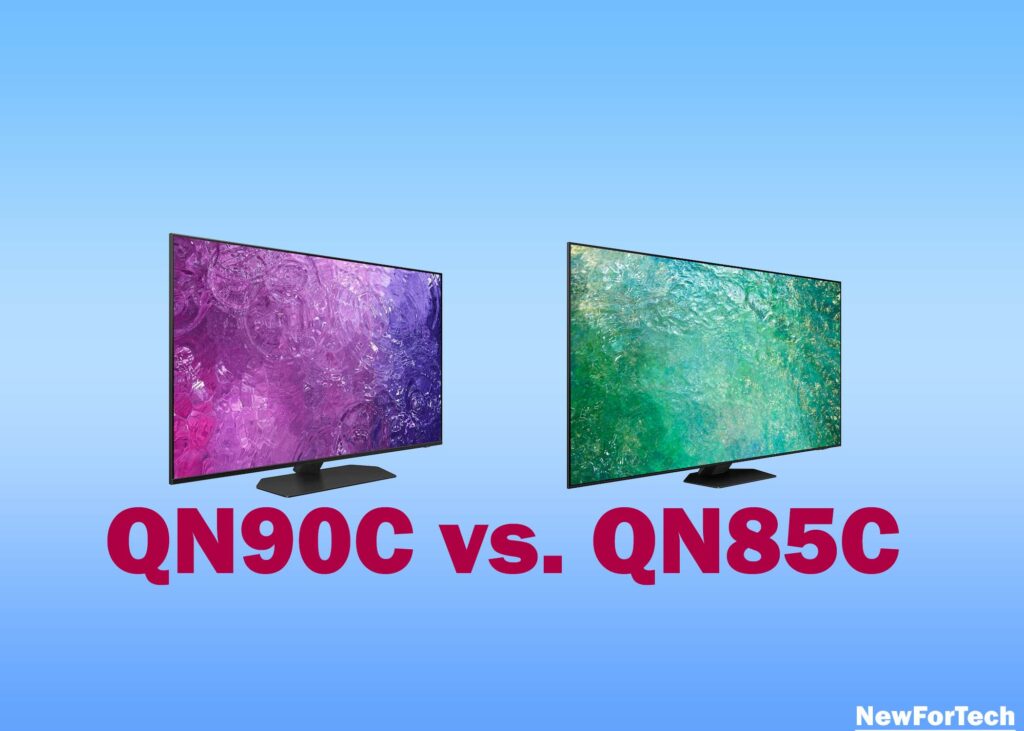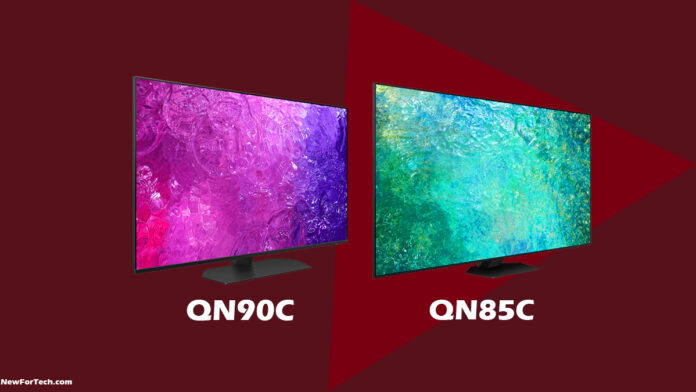Exploring Samsung’s 2023 Mini-LED TVs, Samsung QN90C vs. QN85C.
Samsung QN90C Neo 65-inch QLED TV

- Sizes: 43-, 50-, 55-, 65-, 75- and 85-inch
- Screen type: QLED with Mini-LED
- Refresh rate: 120Hz
- Smart TV: Tizen
The QN90C, part of Samsung’s 2023 Neo QLED mini-LED TV series, offers brilliance and intricate shadow detail through superb local dimming. It features an anti-glare screen for optimal visibility in well-lit spaces and an Ultra Wide Angle capability for versatile viewing. While pricier than rivals like TCL and Hisense, the QN90C stands out with a sophisticated smart TV interface and impressive gaming features.
Pros:
- Exceptional brightness
- Anti-glare display
- Impressive gaming functions
Cons:
- Occasional backlight issues
- Slightly higher cost compared to budget mini-LED competitors
Samsung QN85C Neo QLED 4K TV

- Sizes: 43-, 50-, 55-, 65-, 75- and 85-inch
- Screen tech: QLED with Mini-LED
- Refresh rate: 120Hz
- Smart TV: Tizen
The QN85C, Samsung’s entry-level mini-LED TV series for 2023, offers a similar feature set to the QN90C, with excellent gaming and streaming options via Tizen smart TV. The design is identical, and it includes built-in Dolby Atmos sound. However, it lacks the QN90C’s anti-glare screen and doesn’t reach the same peak brightness. Value-wise, it lags slightly behind the QN90C, which costs only marginally more at most sizes.
Pros:
- Impressive picture and sound
- Sleek design
- Strong gaming features
Cons:
- Occasional backlight problems
- Moderate brightness
- Marginally more expensive than budget mini-LED options
Samsung’s Neo QLED TVs, flagship LCD-based models, distinguish themselves from standard QLEDs by incorporating mini-LED backlighting. While this increases costs, the gap between the top QLED model (Q80C) and the cheapest mini-LED offering is minimal.
Why opt for a mini-LED backlight? Primarily for its remarkable brightness. Mini-LED TVs outshine QLEDs with standard LED backlights, offering advantages for sports enthusiasts and HDR movie enthusiasts, as they maintain full highlight detail without needing tone-mapping.
Samsung introduces three Neo QLED TVs 2023: QN95C, QN90C, and QN85C. Although the QN95C is yet to launch in the US, we’ve evaluated the other two, both available in the US and beyond. A detailed comparison between the QN90C and QN85C will help you decide which Samsung mini-LED TV suits your needs.
SAMSUNG QN90C vs. SAMSUNG QN85C: PRICES AND SIZES
Both the QN90C and QN85C offer sizes from 43 inches to 85 inches. Prices have dropped significantly since their spring 2023 launch, with holiday sales minimizing the price difference.
During Amazon Prime Day, the 65-inch QN90C matched the QN85C’s price, a trend that may continue during Black Friday TV sales.
| Samsung QN90C | Samsung QN85C |
|---|---|
| QN43QN90C: $1,119 | QN43QN85C: $1,099 |
| QN50QN90C: $1,319 | QN50QN85C: $1,199 |
| QN55QN90C: $1,519 | QN55QN85C: $1,299 |
| QN65QN90C: $2,299 | QN65QN85C: $1,699 |
| QN75QN90C: $2,599 | QN75QN85C: $2,199 |
| QN85QN90C: $3,999 | QN85QN85C: $2,599 |
SAMSUNG QN90C vs. SAMSUNG QN85C: FEATURES
Samsung’s mini-LED TVs share key features. Both support HDR10, HDR10+, and HLG (but not Dolby Vision), employing Samsung’s Neural Quantum Processor to enhance HD to 4K. They excel in gaming, offering four HDMI 2.1 ports with 4K 120Hz capabilities and Samsung’s Gaming Hub for cloud gaming through Xbox, Nvidia GeForce Now, Amazon Luna, Utomik, Anstream Arcade, and Blacknut. Input lag is impressively low at 9.8ms on both.
For streaming and smart home control, Samsung relies on the Tizen smart TV interface. An exceptional Ambient Mode allows you to choose from various images to display when the TV is idle. You can also upload your images using the Samsung SmartThings app, which also manages TV setup and control. Both models come with a solar-powered remote, capable of drawing power from your home’s broadband network if the solar cell is obstructed.
A point of note for US viewers: the QN85C’s built-in digital TV tuner supports the older ATSC 1.0 standard, whereas the QN90C supports the ATSC 3.0 ‘NextGen’ standard.
SAMSUNG QN90C VS. SAMSUNG QN85C: DESIGN
Both QN90C and QN85C share the sleek ‘NeoSlim’ design with a hexagonal plate stand, resembling high-end computer monitors. Connections, including 4 HDMI 2.1 ports, USB, optical digital audio, and RF antenna, are tucked neatly into a slim side panel.
SAMSUNG QN90C VS. SAMSUNG QN85C: PICTURE QUALITY
Comparing QN90C to QN85C for picture quality, both excel in several aspects. They deliver accurate colors in Movie mode and offer excellent local dimming for ‘infinite contrast.’ Deep blacks and ample shadow detail are notable.
Both models exhibit impressive motion handling, making panning shots and gaming sequences appear clear with minimal input lag. However, some backlight ‘blooming’ is visible, particularly in white-on-black movie titles, albeit less pronounced on the QN90C.
Notably, the QN90C boasts higher peak brightness at 1,787 nits, making it an excellent choice for daytime sports viewing. Its Ultra Wide Viewing Angle enhances off-center viewing. The QN85C’s Wide Viewing Angle performs well but doesn’t match the QN90C in this regard.

SAMSUNG QN90C VS. SAMSUNG QN85C: SOUND QUALITY
Surprisingly, both slim Samsung models deliver clear, spacious sound. The QN85C boasts a 2.2.2 Dolby Atmos speaker setup, while the QN90C enhances it to a 4.2.2 configuration.
Object Tracking Sound refines dialogue and sound effects, enhancing spatial accuracy. Additionally, Q-Symphony allows the blending of TV audio with Samsung soundbars for an improved experience.
Although both models offer above-average TV sound, they lack bass depth, benefiting from the use of high-quality soundbars, whether Samsung or other brands.
SAMSUNG QN90C VS. SAMSUNG QN85C: CONCLUSION
To determine the superior Samsung mini-LED TV, we need to consider the QN90C and QN85C. Both offer great features for gaming and movie viewing. They share a sleek design, a responsive Tizen smart TV interface, and a solar-powered remote with solid built-in sound.
The key distinctions lie in picture quality, with the QN90C delivering higher peak brightness, anti-glare screen, and superior off-center viewing. While the QN85C isn’t lacking, especially in dim lighting, the QN90C’s peak brightness elevates HDR movie impact. Additionally, the QN90C features an ATSC 3.0 digital TV tuner, which may matter to some, while the QN85C relies on ATSC 1.0.
When making a choice, value plays a crucial role. The QN85C’s price, hovering near the QN90C’s, may not offer the best value. This consideration often tips the scales in favor of the QN90C, though either TV will likely satisfy most users.

